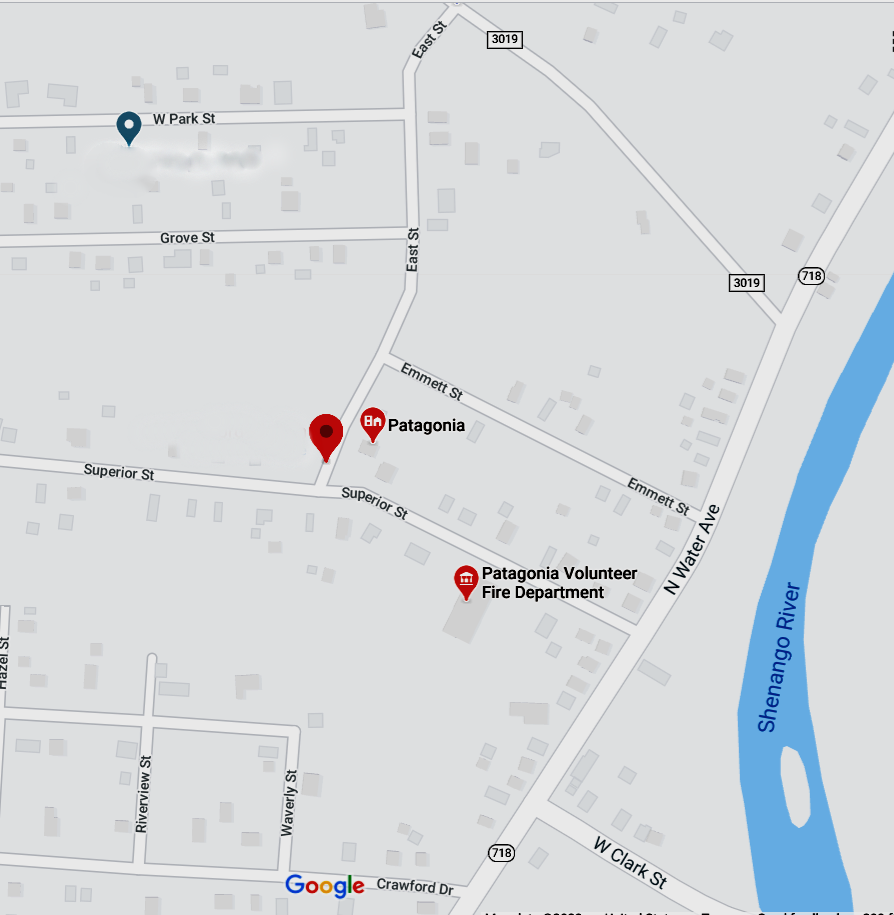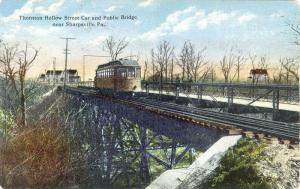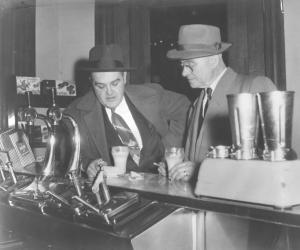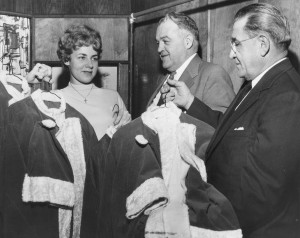WESTINGHOUSE Park Baseball Field
by Ann Angel Eberhardt
Dick Hudson, our guest author, knows a thing or two about sports. The deep interest he had for sports as a kid continued throughout his adult life. His achievements in college sports gained him places in the Sport Halls of Fame at Slippery Rock University and at Mercer County, PA. Later, after earning his doctoral degree at the University of Georgia, he spent most of his career in charge of the University’s 1996 Olympic involvement and as a Consultant to the 2000 Sydney Olympics, among many other activities. See “Patagonia Memories” for more about Dick.
Here are Dick’s fond memories of the ball fields of his youth, particularly the Westinghouse Park Baseball Field. A brief history of the Sharon’s Westinghouse plant follows his narrative.
Westinghouse Park Baseball Field
Corner of State Street and South Buhl Farm Drive, Sharon, PA
By Dick Hudson

Uniform 1940’s Era,” featured on WorthPoint.com.
The Shenango Valley has had plenty of baseball fields over the many years the game has been played. They could be found in the neighborhoods of Sharon, Farrell, Sharpsville, West Middlesex, Hermitage, and surrounding towns of Greenville, Jamestown, Mercer, Transfer/Reynolds, and Grove City.
These fields were carved out of plots of land in all kinds of local environments and built to accommodate various age groups of players, from Little Leagues to Pony Leagues and Babe Ruth Leagues, to American Legion Leagues and Independent Leagues. All the fields had their own attractions, idiosyncrasies, legendary players and games, and held memories from the ages in the worn dirt infields and outfield grasses.
For me, the North Sharon Little League field, huddled at the bottom of a hill and set perfectly in its limited space, was the first one where I played. It was built in the very early 1950s when Little League baseball first arrived in Sharon and had four teams with names such as the Tigers and the Yankees. These names were later changed when team sponsors arrived and the teams took on the sponsors’ names, such as BPO Elks.
Across town, the South Sharon Little League played on a field on Wengler Avenue, and the All-Stars from each league would often play at the end of the year in playoffs. We knew about names from the other league but only got to know them when we got out of Little League and joined teams for 13 to 15-year-olds (called the Babe Ruth League when we played).
But, again, all the towns and neighborhoods had their fields, and only much later when playing in the Pymatuning League did I get to play on fields in these other area towns.
Growing up and being fascinated by baseball, we watched older players playing at levels that seemed beyond anything we could ever do. How could they throw the ball so fast and so far; how could they hit it; and how could they always seem to catch every ball hit or thrown? We marveled at all of this, and spent our summer days (and winter days in basements) practicing what we had seen.
There was one baseball field that I saw on occasion when very young (six to ten years old). Once when I was about five years old my father was there playing or practicing (maybe even softball), so I was there on the field. It was the first time I held a leather glove and I was completely taken by its feel and its smell.
This field, I later learned, was the Westinghouse Park Baseball Field, a field on a big lot on the corner of State Street and South Buhl Farm Drive. The big Westinghouse Plant built this park for its employees, as the plant in 1956 had about 10,000 working at the plant. The Park had picnic tables out beyond the baseball field, as well as some big fields and a wooded area.

A gravel parking lot (most fields had dirt parking lots) was beyond left field, which was about 300 feet along the line. There was no fence around the big green outfield, but from the foul line in left field straight across left centerfield and then out way past where a centerfield fence would have been was a small hill/incline, maybe going up about 10 feet at an angle and being about six feet higher at the top than the field. When it rained a lot, there would be a small area near the foul line and close to where the bank started that would form a small puddle. In right field, there was also such a hill, but it went the other way from the infield and outfield and down a sloping bank where the grass went another few hundred feet and approached the original McDonald’s restaurant on State Street. If an outfielder went for a ball over that hill, he would quickly disappear from view from the infield.
The infield was dirt, large, and always in great condition, with a tall backstop only about 10 feet behind home plate. Benches were on both sides of the foul lines and behind the benches were small bleachers, extending out behind the third and first base bags a bit.
Along the third base side and toward the top of the slight hill along South Buhl Farm Drive and all the way out to the parking lot beyond left field was a row of tall, majestic trees that lined the road that ran parallel to the left field foul line. Cars would sometimes park off the road and under these trees to catch a peek at a game in progress.
About 30 feet from the left field foul line, there was an incline/hill that stretched up to that row of big trees, and people would often sit there on the ground or on folding chairs, lining the hill all the way out to the parking lot.
And the grass! This field, the Elysian Field of the Shenango Valley, had grass greener than any of us had in our yards or neighborhoods, and seemed to rival the green that we saw when going for the first time to a major league game in Pittsburgh or Cleveland.
I now live in Athens, Georgia, area (University of Georgia), and in 1964 the Westinghouse plant in Sharon moved many to Athens to work at a new distribution transformer Westinghouse plant that opened here in 1958 (it later became ABB in 1990). Over the years I have met several who came to Athens from Sharon and they all remember Westinghouse Park Baseball Field.
As do I and so many others . . .
— Dick Hudson (Hickory High School 1963), Colbert, Georgia.
ABOUT THE SHARON WESTINGHOUSE PLANT

In the 1950s, many of the people who lived in the Sharpsville area either worked in the steel mills or at the Westinghouse plant. Neither the mills nor the plant exist any longer but the sprawling 50-plus-acre Westinghouse building and office complex still front North Sharpsville Avenue (Route 518), not far from downtown Sharon, Pennsylvania. When I lived in Sharpsville in the 1950s and traveled to and from Sharon by car (and particularly on foot), the red brick northern part of the structure with its row after row of tall paneled windows, seemed to stretch forever but it is actually about one mile long.
When the Westinghouse Electric Corporation constructed its plant in 1922, it was known as the “Sharon Works” and produced electric transformers. An interesting historical note is that, during World War II, the plant produced silent torpedoes with electric motors under the supervision of the U.S. Navy. That section of the building still has a 3-foot-thick, reinforced-concrete roof originally built to protect against enemy bombing. The torpedoes were tested at Pymatuning Lake and a unit of a torpedo was tested at Buhl Park’s Lake Julia.
During the two decades after the war, Westinghouse’s Sharon plant reached a peak of nearly 10,000 employees. However, the plant closed permanently in 1985, dealing another blow to the already economically depressed area. In 2016, a state grant funded a massive overhaul of the deteriorating building, and the resulting renovation now known as The Landing, has attracted several businesses. Last year, the Sharon Historical Society sponsored a popular tour and history presentation of the old Transformer Division.
— Ann Angel Eberhardt (Sharpsville High School 1958), Goodyear, AZ.
Sources (Accessed July 13, 2020):
Engelmayer, Caroline S. “After Westinghouse: Sharon tried to revive its economy but old factory’s environmental hazards lurk.” Pittsburgh Post-Gazette, July 9, 2020. Internet resource.
Pinchot, Joe. ‘Torpedo’ examined.” The (Sharon) Herald, March 3, 2013.
Roknick, Michael. “State Pumps $3 million into overhaul of Sharon’s former Westinghouse plant.” New Castle News, November 28, 2016. Internet resource.
Other “Small Town Memories” Posts by Dick Hudson:
PATAGONIA Memories: Patagonia School: A Four-Room Schoolhouse
on East Street
How PATAGONIA (PA) Got Its Name: Patagonia, Hickory Township’s
Family to the West









































